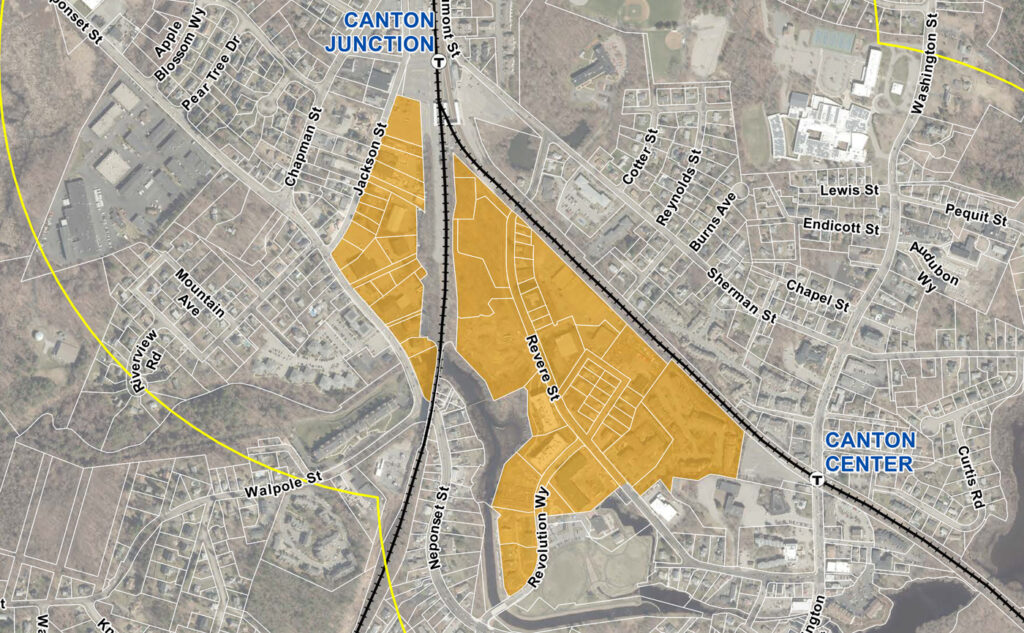MBTA zoning plan heads to town meeting
By Jay TurnerA simmering debate over zoning regulations, and specifically whether or not to comply with a new state mandate allowing for multi-family housing, is about to come to a head in Canton as residents prepare to cast their votes at the 2024 Annual Town Meeting beginning Monday, May 13, in the Canton High School auditorium.
The zoning proposal in question, detailed in the warrant under Article 32, would establish a new overlay zoning district spanning 56 acres between the Canton Junction and Canton Center MBTA stations. Drafted by a working group of town officials with input from residents, the proposed district has the unanimous support of the Finance Committee, Planning Board and Select Board and would meet all of the requirements of the MBTA Communities Act (MGL Ch. 40A, sec. 3A).
Under the provisions of the new law, cities or towns within the MBTA’s service area — 177 communities in all — are required to have at least one zoning district that permits multi-family housing “as of right,” meaning without requiring a special permit. Multi-family housing, for the purposes of this law, refers to housing with at least three units on one piece of property. The law also stipulates that the district should be within a half mile of a commuter rail station, and the housing cannot have age restrictions and must be suitable for families with children.
What the law does not do, however, is mandate the actual production of housing, according to Town Planner TJ Torres.
“All we’re doing is charting out the zone,” Torres explained in a recent presentation given at Town Hall. “Think of it as a recipe — we can put the recipe in place, but it is completely up to those private property owners in the zone whether they want to cook it or not.”
During the presentation, which was taped by Canton Community Television, Torres teamed with Planning Board Chair Patricia McDermott and Housing Coordinator Kevin Shea to give an overview of the proposed zoning district while also attempting to dispel some of the common myths that have surfaced in relation to the MBTA Communities Act.
One such myth, according to the presenters, is that the state is “telling [communities] what to do,” when in reality, they said, cities and towns have been given a great deal of flexibility in how to craft the new zoning and where exactly to draw the borders.
In Canton’s case, Torres said the working group selected an area that had already been targeted for this kind of housing as part of a recently completed study commissioned by the town in collaboration with the Metropolitan Area Planning Council (MAPC). Additionally, he said they intentionally chose an area that had already been developed with multi-family housing (encompassing the Paul Revere Heritage Site), and one that represented only a fraction of the land within a half mile of Canton’s two commuter rail stations — and just 0.45 percent of the total land area in the town.
In response to feedback from residents, Torres said they inserted requirements that would incentivize condominiums or complexes as opposed to smaller triplexes, including one-acre minimum lot sizes and a stipulation that at least 30 percent of the land on any new development be set aside as common open space. He added that all new developments would be subject to a site plan review process and would have to comply with Conservation Commission regulations, local performance standards and design guidelines, and all applicable state and local building codes.
Torres said it was also the town’s decision to require that 10 percent of units in all multi-family developments within the district be designated as affordable “in order to avoid future 40B developments.” He said it is a common misconception that the state is forcing communities to build “low-income housing” when the MBTA zoning law, in fact, has no affordability requirements.
“This is not an affordable housing policy; it never was,” said Torres. “It was meant to be a housing production policy.”
Critics of the state mandate, however, argue that it is overly intrusive and could lead to unintended consequences. Larry Overlan, chair of Canton’s Republican Town Committee and a columnist for this newspaper, has likened it to a “modern-day British Quartering Act.” Others have characterized it as a form of legal and financial coercion, pointing to lawsuits that have been filed against noncompliant communities as well as the withholding of grants.
The Canton Select Board itself has expressed “great concern” with the zoning mandate but also recognized that “it is a law” and therefore the town is required to comply.
And while Milton voters rejected their zoning plan in a referendum and Marshfield did the same at a recent special town meeting, Shea said the state appears to have the legal upper hand. “[In the Milton case], the attorney general has pointed out that if the town was unable or unwilling to comply, then the state would appoint a special master to propose the zoning laws that do comply,” he said.
Shea added that communities that refuse to comply would lose eligibility for more than a dozen state grants yet would still face a costly lawsuit. “The AG has noted that communities can’t avoid their obligations by simply forgoing grant funding. That’s not an option at all,” he said.
Torres cautioned that most communities that have voted on the measure have supported compliance, which he said does not bode well for the handful of holdouts. “The way the law is written, the enforcement can only grow,” he said. “December 2024 is the deadline for compliance, and then you’re really going to see the depths of enforcement.”
McDermott reminded the audience that it was the commonwealth’s business leaders who pushed for the law in the first place, lobbying Beacon Hill about the need for more workforce housing to ensure Massachusetts can stay competitive. “If we allow our working demographic to diminish,” she said, “it will be detrimental to our schools, our healthcare system, first responders, infrastructure, and industries as a whole, not just in the commonwealth but in the town of Canton.”
For more information and resources related to the MBTA zoning proposal, go to town.canton.ma.us/1002/3A-MBTA-Zoning.
Short URL: https://www.thecantoncitizen.com/?p=124314











